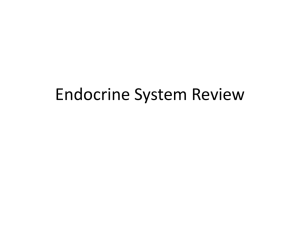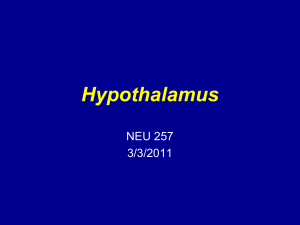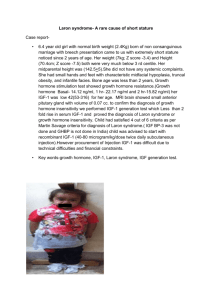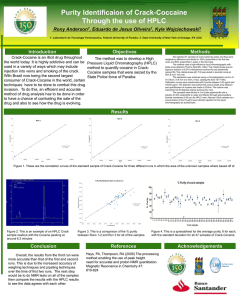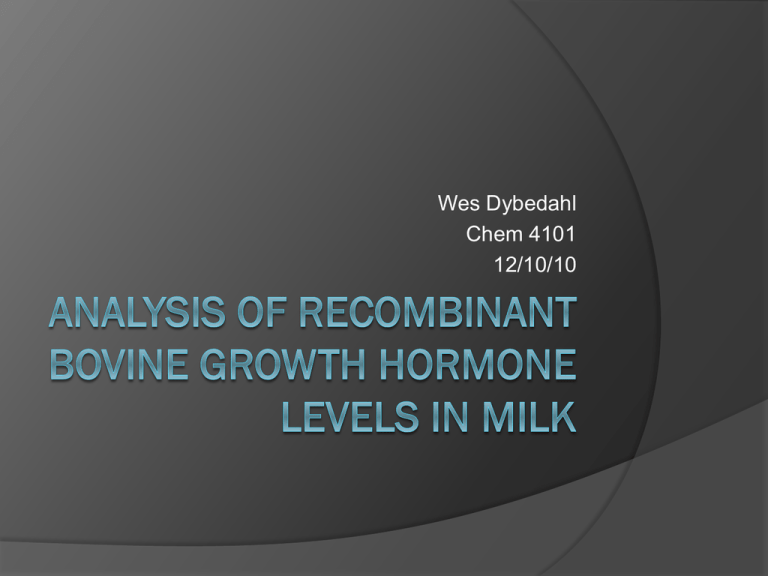
Wes Dybedahl
Chem 4101
12/10/10
Background
Image source (2)
Bovine Somatotropin is a naturally
made hormone found in cow which
has been studied and shown to
correlate directly with milk
production.
In order to help increase milk
production, a synthetic version,
recombinant bovine growth
hormone (rBGH/rbST) was
develoved by Monsanto in 1994
under trade name Posilac©, and is
now owned by Elanco.(8)
The synthetic version is nearly
identical to the natural hormone
with the only difference in the 191
amino acid chain being a
Methionine on the N-terminus
instead of an Alanine.
Problem
• Concerns have been made over the recombinant form as to whether
it may cause harm to the cows or humans who consume the milk.
• Results so far have been inconclusive in showing any adverse effects
due to the added hormone but studies have shown rBGH
supplementation causes an increase in insulin growth factor-1 which
has been suggested to increase risk of breast and colon cancer.(1)
• Evidence opposing it’s use suggest that the increased hormone levels
cause diseases such as mastitis in cows which forces the farmers to
use more antibiotics. The increase in antibiotics has been accused of
being present in milk and may be aiding bacterial resistance. (3)
• This evidence has led to the hormone being banned in Canada,
Australia, Japan, and the European Union.
Hypothesis
The central hypothesis is to obtain an
accurate and efficient method that will be
able to distinguish the synthetic form over
the natural form and properly measure those
levels in milk samples.
HPLC-MS/MS
The method that will provide
the best resolution and
accuracy for the desired
analyte would be HPLC
coupled to tandem MS.
Detection of the proteins at
low sample volumes
possible
Fairly quick analysis time
With HPLC, an internal
standard can be used with
control samples in order to
accurately quantify sample
levels.
Instrumentation
(1)
HPLC system: Agilent 1200
Column: C18 Interchrom QS Uptisphere 3HDO
150 mm × 2 mm, 3 μm, 100 Å. This column would
provide optimum separation for the polarity
differences found on the amino acid chains from
the proteins found the sample matrix.(4)
Mobile phase: acetonitrile + 0.1% formic acid (A)
and water + 0.1% formic acid (B).
The total run time was 20 min The solvent flow rate
was 300 μL min−1 and injection volume 20 μL.
MS instrument: API 5000, triple quadrupole, fitted
with an electrospray ion source in positive mode.
capillary voltage: 5000 V
nebulizer: 55 psi,
gas flow: 13 L min−1
gas temperature: 300 °C.
(5)
Sample Preparation(1)
To try and remove the desired analyte from the other things found in
the matrix for milk several steps need to be made in the preparation.
The sample first must be spiked with 100ng/mL of reST as an internal
standard. Then mixed with 10mL of water and 10mL methanol into a
solid phase extraction cartridge, followed by two washings, first with
5mL water/0.1% TFA, then 5mL water/acetonitrile (70:30) 0.1%TFA.
The samples are then eluted with 7mL of 20:80 water/acetonitrile mix
with 0.1% TFA, followed by an evaporation by nitrogen stream.
The proteins, which contain the hormone, can then be precipitated out
by 5mL of cold methanol, and then centrifuged to remove the top layer
of un-needed fat. The proteins then need to be digested by 2ug trypsin
in 100uL of ammonium bicarbonate, 50mM and 20uL acetonitrile.
Finally, the extracts are evaporated and reconstituted with 40uL of
80:20 mix water/acetonitrile, containing 1ug/mL 13C labelled N-terminal
tryptic rbST and 0.1% formic acid for an external standard.
Results
•The analytical method gives an accurate quantification of the rbST
within the sample, through comparison of the chromatogram with
the control samples.
•Selectivity is also superb for this technique, with no peak
interferences occurring.
Chromatogram for N-terminal peptides from blank milk samples and those spiked with 25 ng/mL rbST. (1)
Method Specifications(1)
Linearity:
Concentration range
20-100 ng/mL
Coefficient of determination
R2=0.992
Slope
a=0.0106
Intercept
b=0.1156
Sensitivity:
LOQ
1.24 ng/mL
LOD
1.92 ng/mL
Precision:
Relative Standard deviation of repeatability
RSD(r)=4.5%
Relative repeatability limit at 95% for duplicate
results
r=12.5%
Trueness:
RSD(Rec)corrected
7.2%
Measurement of uncertainty:
Standard uncertainty
u=19.4%
Expanded uncertainty
U=38.8%
Alternative methods
Method
Pros
Cons
Capillary
Electrophoresis(5)
Separation of different
protein chains, fast
analysis times
Not strong enough to be
used alone
Fluorescence
Highly sensitive for
detecting Trp within the
hormone
Sample preparation,
matrix interference.
Sensitive and selective
electrochemiluminescent method
immunoassay(6)
Difficult to distinguish
synthetic from natural
hormone
Conclusion
•There is still much debate as to whether or not the use of
recombinant bovine growth hormone poses harm to humans.
•With further developments in biological analysis, the hormone
will be able to be monitored in the body to determine any
possible negative effects that may be occurring.
•The methods previously discussed will provide accurate
analysis of the synthetic hormone found in milk samples and,
in turn, will be able to help in measuring for determinations of
possible adverse effects.
References
1)
Le Breton, Marie-Hélène; Beck-Henzelin, Andrea; Richoz-Payot, Janique; Rochereau-Roulet,
Sandrine; Pinel, Gaud; Delatour, Thierry; Le Bizec, Bruno. Analytica Chimica Acta, Jul2010, Vol.
672 Issue 1/2, p45-49, 5p; DOI: 10.1016/j.aca.2010.04.030; (AN 51811641)
2)
John, Y., and Rodney Pearlman. Stability and characterization of protein and peptide drugs: case
histories. 5. New York, NY: Springer Us, 1993. 67-71. Print.
3)
“The Issues: rBGH”. Sustainable table. July 2008. December 2010.
http://www.sustainabletable.org/issues/rbgh/.
4)
http://www.chem.agilent.com/enUS/Products/Instruments/lc/analytical/systems/1290infinitylc/Pages/default.aspx. Dec 5, 2010.
5)
Pinel, G.; Buon, R.; Aviat, F.; Larre, C.; Andr-Fontaine, G.; Andr, F.; Le Bizec, B.Recombinant
bovine somatotropin misuse in cattle. Evaluation of western blotting and 2D electrophoresis
methods on biological samples for the demonstration of its administration Anal. Chim. Acta 2005,
529, 41– 46
6)
M.F. McGrath, G. Bogosian, A.C. Fabellar, R. Staub, J.L. Vicini and L.A. Widger, Journal of
Agricultural and Food Chemistry 56 (2008), pp. 7044–7048.
7)
http://www.chemguide.co.uk/analysis/chromatography/hplc.html. Dec 5, 2010
8)
Posilac Information. Elanco. http://www.elanco.us/products/posilac.htm. 2010. Dec 6, 2010





